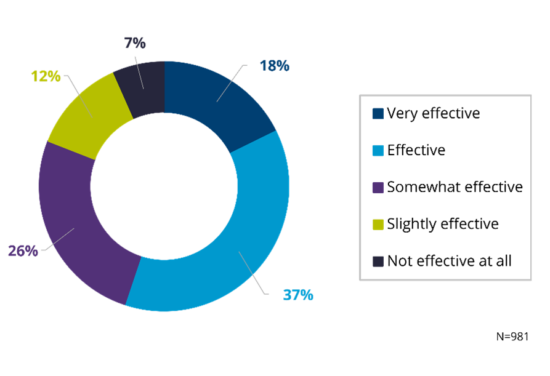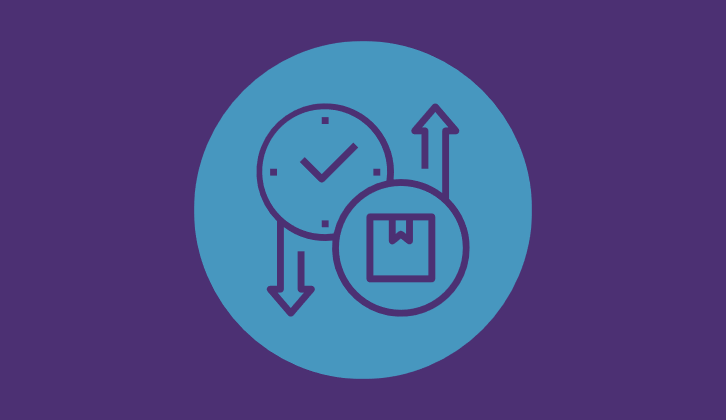Productivity refers to the effectiveness and efficiency of work, and it’s a crucial factor in the success or failure of any enterprise.
Organizations often focus productivity assessment and improvement efforts at the employee level, and this makes sense, because individuals’ productivity or lack thereof is a huge input into the organization’s overall productivity.
Unfortunately, managing employee productivity is notoriously difficult and laden with potential pitfalls — especially when your employees are knowledge workers. Common — and not-so-common — techniques for managing employee productivity can help.
How organizations manage productivity today
In our Fixing Knowledge & Process Productivity Problems research, APQC surveyed 981 knowledge workers to understand how these workers and their organizations manage productivity. We asked respondents, “How is your work productivity measured?” (Figure 1).

The most popular techniques are also the most subjective
The top two techniques (depicted in dark blue in Figure 1) are manager observation and self-reporting, both of which are subjective. Manager observation is shaped by the personal bias of the manager, while self-reporting is shaped by the personal bias of the employee. These approaches also generate inexact data, because manager observation is often incomplete, and employee self-reporting is often performed retroactively.
In addition to being inexact, the data gathered through these techniques also tends to be heterogeneous. Manager observation and self-reporting might be sufficient for identifying one particularly unproductive employee (or one super-productive “rock star”), but these techniques don’t allow for the kind of apples-to-apples comparisons you need to find and fix productivity problems at scale.
Team-based tracking is more holistic
Team-based measurement and tracking, by contrast, is a more holistic and objective technique for gauging knowledge workers’ productivity. For knowledge workers, productivity is a “team sport,” because knowledge workers rarely have complete, singular ownership of their inputs and outputs.
Consider the following example: For the organization to deliver solution XYZ, one employee needs to complete task A. Then she hands off her results to another employee to complete task B, who then collaborates with other employees to complete tasks C and D, and so on.
If the delivery of solution XYZ is too slow or of insufficient quality, how would you find and fix the problem?
- If you use manager observation, you only identify the productivity problems the manager can see (and they can’t see everything)
- If you use employee self-reporting, you can only identify productivity problems that employees self-report (and, you might find that every employee thinks he or she is doing a great job)
- If you use team-based tracking, you’ll be better equipped to spot big-picture problems such as bad handoffs, redundancies, and non-value-added steps across the delivery of the solution
Only 30% of those surveyed said their organizations use team-based measurement, which makes sense given that it’s a bit harder — but certainly not impossible — to implement. To use this approach effectively, managers need to work with their teams to identify measures that everyone agrees upon as fair, relevant and actionable.
Productivity tools are less common than you’d think
There’s been a lot of hype around productivity tools, especially over the past two years as managers have struggled to manage in remote and hybrid environments. Key tools that fit into this category include:
- Email analytics: Tools that analyze communication patterns through email activities (receiving and sending) as well as response times
- Time trackers: Tools that use timers to objectively measure employee time spent on explicit tasks, which allows managers to sort and analyze time spent on tasks per category
- Task and project management apps: Tools for organizing projects and related tasks to create transparency around projects and manage the efficiency of project efforts
- Activity trackers: Tools that provide insight into how and where employees speed their time through keystroke counters, mouse movement trackers, screen capture and website tracing
While these technologies get a lot of attention in the media, APQC finds that they are relatively uncommon — at least, for now. Organizations sometimes struggle to align the structure and capabilities of these tools with their unique work environments (e.g., adapting a project management app to the way your organization manages projects).
Additionally, employees often see productivity tools as unfair and overly intrusive—and they’re not entirely wrong. Some tools, particularly “trackers,” are prone to misinterpretation and pave the way to micromanagement. Even leaders tantalized by the potential benefits of these tools must also weigh the risks: legal and privacy issues, poor employee engagement and retention, and the curtailment of innovation.
Do productivity tools actually work?
The answer depends on how you define “productivity.” These tools are best at tracking measures like time-on-task, throughput, and cycle times.
As we’ll discuss further in the measurement section, these are efficiency measures. These kinds of measures are helpful in some ways, and it’s a good idea to include them in your measurement portfolio, but they cannot capture the full picture of knowledge worker productivity.
The missing ingredient: peer feedback/review
APQC finds that only one out of four knowledge receives peer observation and feedback on their productivity. To the majority of organizations that don’t employ this technique, APQC strongly recommends exploring and implementing it. Collecting feedback from those whom employees work most closely with — including teammates, managers and reports — is a proven training and development best practice for assessing productivity and performance.
Why?
- It’s holistic: It incorporates the viewpoints of different stakeholders to paint a more complete picture of each employee and the team as a whole
- It’s equitable: It gives all stakeholders an opportunity to give and receive feedback
- It helps employees grow: Over time, employees hone their ability to give, receive and act upon each other’s feedback
Measurement
Measures are a key ingredient in the management of productivity and performance. When you choose the right measures, you have objective inputs for assessing performance, identifying challenges and opportunities for improvement, and quantifying intangibles such as effectiveness and quality.
When APQC surveyed knowledge works about the measures used to gauge their productivity, we were pleased to see a greater emphasis on effectiveness than efficiency (Figure 2).

Effectiveness measures: These capture the accomplishment of an objective or desired result — in other words, the value, quality, completion-to-plans or outcome of the process. Related measures include conversion rates, customer retention and first-pass yield.
Efficiency measures: These capture the throughput of an individual or process. The most common measure of efficiency is output to input divided by costs. Related measures include employee or full-time equivalent hours, cycle times, throughput and costs.
Both kinds of measures are key for balanced perspective of productivity, but effectiveness measures are especially important for assessing knowledge worker productivity. Efficiency measures help you determine whether you’re doing things right, while effectiveness measures help you assess whether you’re doing the right thing.
For example, to improve the productivity and performance of a sales team, you’d want to have an efficiency measure — like the number of calls completed — to make sure your salespeople are doing what they’re supposed to do.
But to really assess productivity and get to the root of any problems, you’d also want to have an effectiveness measure — such as percentage of qualified leads — to ensure your salespeople are doing the right thing when they’re making those calls.
Employees appreciate a balanced set of measures
It’s not just APQC that thinks a balanced portfolio of effectiveness and efficiency measures is smart—employees think so, too. More than half of our survey respondents said the measures their organizations use to assess productivity are effective or very effective (Figure 3).

This finding tracks with the results displayed in Figure 2, which show that most knowledge workers are assessed with balanced set of measures with an emphasis on effectiveness measures.
What matters most: The “How”
Managing employee productivity is a must-do for all organizations. But to get actionable insights and results, organizations need to think carefully about how they manage and monitor productivity.
APQC urges organizations to use a combination of objective measures and subjective observation. In other words, use data to capture the breadth of performance, but combine that with the nuance and contextual information provided by observation.
Of course, what happens with the “how” hinges upon “who” is doing it. It’s up to managers to ensure employees have the data and feedback they need to understand and improve their productivity.
APQC recommends regular check-in meetings between managers and employees to discuss progress, accomplishments, priority shifts and problems to solve.
These conversations should aim to empower rather than micromanage. Micromanagement is a hard habit for many managers to shake (especially when they have access to data from productivity tools), but it hinders performance.
Holly Lyke-Ho-Gland is principal research lead, Process & Performance Management, at APQC.
If you liked this article and video, sign up for SmartBrief’s free email newsletter on leadership. It’s among SmartBrief’s more than 250 industry-focused newsletters.
